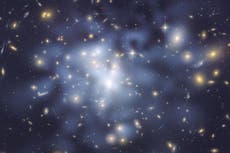Monster black hole at galaxy’s centre not as dormant as previously thought, study finds
‘It is as if a single glow-worm hidden in a forest suddenly became as bright as the Sun’
The supermassive black hole at the heart of the Milky Way galaxy is not as dormant as previously thought, according to a new study.
Astronomers, including those from CNRS in France, have discovered that Sagittarius A*, the supermassive black hole at the centre of the Milky Way, emerged from a long period of dormancy some 200 years ago.
A new research, published last week in the journal Nature, has unveiled the past awakening of this gigantic cosmic object, which is about four million times more massive than the Sun.
Previous studies have shown that ultramassive black holes in the middle of galaxies go dormant after gobbling up nearby matter.
“Imagine a bear going into hibernation after devouring everything around it,” the study’s first author Frederic Marin from the Strasbourg Astronomical Observatory in France told AFP.
Researchers now believe that over a period of one year at the beginning of the 19th century, the black hole swallowed cosmic objects that got close to it, before entering a state of quiescence again.
There was still no effect on Earth from this black hole becoming active since the distance between the monster colossal entity and our planet is much greater in the order of about two billion times the distance from the Earth to the Sun.
However, based on the X-ray echo detected, which was emitted about 200 years ago, researchers say the original intensity of the radiation was at least a million times greater than that currently emitted by the supermassive black hole.
The surge in X-rays was as if “a single glow-worm hidden in a forest suddenly becomes as bright as the Sun,” scientists say.
The new findings, according to researchers, also explain why molecular clouds near Sagittarius A* are shining more brightly than usual.
They say it is because these galactic clouds are reflecting the X-rays emitted by Sgr A* 200 years ago.
For the study, scientists used NASA’s IXPE satellite which was available for the very first time to detect and locate this X-ray light with great precision.
Researchers are currently trying to determine the physical mechanisms required for a black hole like Sagittarius A* to switch from a dormant to an active state.
Join our commenting forum
Join thought-provoking conversations, follow other Independent readers and see their replies
Comments


Bookmark popover
Removed from bookmarks